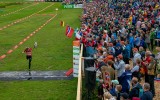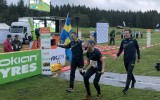Sweden is tipped by many to make a killer result in this year’s WOC. WOC 2019 host city Sarpsborg has been ravaged by the Swedes before during its long history.
Situated by Norway’s longest river Glomma and intersected by freeway and railways; WOC centre Sarpsborg is literally at a crossroads and has been so since ancient times.
Today’s WOC guests will arrive by car, bus and train. The first people in Sarpsborg came paddling in boats. They where hunters and gatherers among the Østfold skerries at a time when the sea level was much higher than now and when Kulås stuck out as a small island in the ocean.
Now Sarpsborg is a modern city with 55 000 inhabitants and with Kulås Park its green playground.
City by the waterfall
Sarpsborg was built around the Sarpsfossen waterfall. The first rapids were formed here 4000 years ago. Since then the waterfall has grown higher and higher following the rising level of the land. Today it is Scandinavia’s most powerful waterfall.
This is where the big river Glomma and the moraine of debris from the last Ice Age meet. On the fertile soils on the south side of the moraine we find some of Norway’s oldest farms. From Tune in present-day Sarpsborg municipality we have the two first Østfold people whose names are known today: Wiwar and Woduride; carved with old Norse runic letters into the Tune Stone some time around 400 A.D.
1003 years old
Three years ago Sarpsborg celebrated its 1000thanniversary. According to saga writer Snorre Sturlason, Sarpsborg was founded by King Olav Haraldsson in year 1016 as the third city in Norway after Tønsberg and Nidaros (Trondheim). King Olav needed a stronghold against threatening Swedes who he fought against over the control of the eastern part of Viken (Østfold). He found the place he needed on a headland pointing into Sarpefossen waterfall. Here the king built a wall, he had houses and roads constructed, a king’s estate and a church. The place became Borg – or Sarpsborg.

Lithography of Sarpsfossen by F. Larsen, 1889 / Wikimedia Commons.
The king himself spent three winters in Borg, according to the saga. In February 1019 he married the Swedish king’s illegitimate daughter Astrid during a great feast where hard-pressed local farmers supplied food and drinks. Eleven years later Olav fell in the battle of Stiklestad and was later declared a saint.
Ravaged by the Swedes
Sarpsborg slid into periphery until it finally was wiped out.
The Seven Years’ War between Sweden and Denmark-Norway lasted from 1563 to 1570 and became disastrous for Sarpsborg. King Erik the 14thof Sweden wanted to conquer Norway, however the Swedes did not succeed in taking the important Akershus fortress in Oslo and had to withdraw. During the withdrawal of forces from South East Norway in the spring of 1567, Sarpsborg was virtually wiped out by fire and looting.
The Danish-Norwegian king Fredrik the 2ndquickly allowed the burghers to found a new settlement further south, near the mouth of the Glomma River. The city was named Fredrikstad.
Rich water power
A few stubborn people remained near the mighty waterfall. Over time new activities grew up based on waterpower, e.g. sawmills. The forests where orienteers now love to run were for a long time Norway’s green gold. From there, timber was taken for export to Europe where numerous ships and houses have been built with boards from Norway.
Two old great properties on each side of the waterfall, Borregaard and Hafslund, have both been starting points for large, modern businesses based on valuable shares in the powerful waterfall.
Industrial city
From the sawmills a new community grew up and Sarpsborg was founded again as a market town in 1839. The main street St. Marie Street follows the top of the old moraine left from the Ice Age. If you attend the opening ceremony and the first spectator race during WOC 2019 on 12 August, you will get ample opportunity to explore the streets around here.

Sarpefossen waterfall with the bridge in the late 1800s. Photo: Axel Lindahl / Nasjonalbiblioteket / Wikimedia Commons.
Industrial facilities dominate the Sarpsborg landscape today, visible to everyone who crosses the bridge over Sarpefossen. In the late 19thcentury factories started to pop up along the river. Borregaard produced cellulose and paper and became Norway’s largest industrial plant. Hafslund delivered hydro-electrical power to businesses and private homes. Other companies were behind a great spectrum of products from cardboard to kitchen stoves.
With the factories came working-class Sarpsborg. Shortly after World War II, 3700 women and men worked at Borregaard. The Labour Party has retained the mayor of Sarpsborg continuously for more than 100 years and as late as the local elections in 2015 the party received more than 50 per cent of the votes in the city.
Sarpsborg today
Industry death during the 1980s forced changes on Sarpsborg, just like many other places. Borregaard still has a dominating presence but today services have replaced industrial production in economic significance. Pride must be sought from other things than shining industrial products although the beer from the Borg brewery still flows.
In 2015 a brand-new hospital for Østfold opened at Kalnes just a few kilometres outside the city. Next-door to the WOC hotel Quality is Inspiria Science Center, a popular attraction. Local ice hockey team Sparta stills scores a lot of goals while the fairly recently established football club Sarpsborg 08 has managed to establish itself in the top flight of Norwegian soccer. The Blues have even made it to the UEFA Europa League.
Should you wish to take a step back in Sarpsborg’s rich history during WOC you can visit the Borgarsyssel Museum which is located in the area where the town was first founded in 1016.

Borgarsyssel Museum in the Sarpsborg city centre provides delightful grounds and a glimpse into local history. Photo: Kvikk / Wikimedia Commons.



